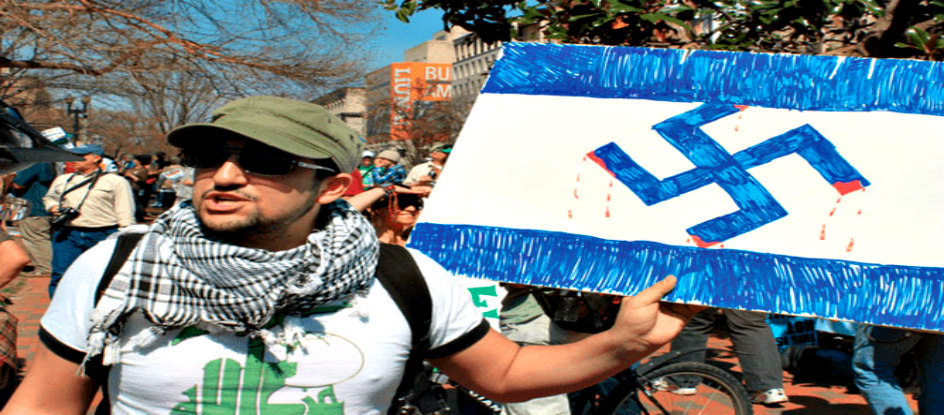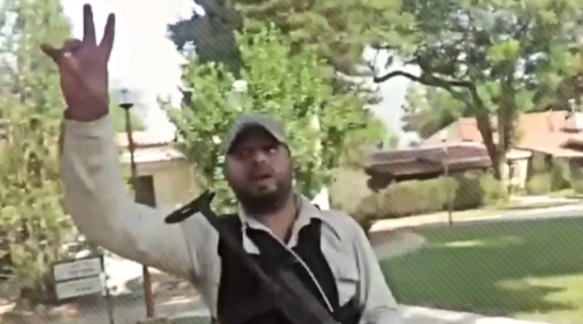American academia, which fosters a distorted version of the Middle East conflict by vilifying Israel, is now trying to hide the rampant hatred directed against Jewish students

For decades, pseudo academic studies have sought to present a distorted narrative of the Arab-Israeli conflict and a misleading account regarding the severity of threats against the Jewish community.
Highlighting this phenomenon, the Research Group of the Concentration in Education and Jewish Studies at Stanford University published a September 2017 report, entitled “Safe and on the Sidelines: Jewish Students and the Israel-Palestine Conflict on Campus,” which attempts to discredit the argument that universities have become “hotspots of antisemitism.”
While the report acknowledges that “Since 2014, there have been at least seven separate studies dedicated to tracking campus political discourse as it pertains to antisemitism and anti-Israel sentiment,” it argues that “what [these studies] offer in numerical impressions, they obscure in the subtleties of student experience.”
While the existing studies – conducted by the Anti-Defamation League (2015), the AMCHA Initiative (2015, 2016, 2017), Barry A. Kosmin and Ariela Keysar (2015), Leonard Saxe et al. (2015, 2016), and others — generated extensive data and statistics, using reported incidents, surveys, polls, and questionnaires, the Stanford study is based solely on personal interviews with sixty-six undefined students across five California university campuses.
In fact, the study acknowledges that it “intentionally sought out Jewish students who were either unengaged or minimally engaged in organized Jewish life,” thereby excluding students who are most likely to either be targets of antisemitic attacks or be cognizant of antisemitism on campus.
Yet, while the report contains fundamental methodological flaws, omissions, and distortions, it is nonetheless repeated on the global stage, presenting a highly inaccurate account of antisemitism on campus.
One must look no further than the cover page of the report to see that the authors include Abiya Ahmed, a former employee of the Council on American Islamic Relations (CAIR), an organization with close ties to Hamas and the Muslim Brotherhood, and Ari Y. Kelman, a member of the Academic Council of Open Hillel.
Seeking to “eliminate Hillel International’s Standards,” Open Hillel gives recognition to supporters of the Boycott, Divestment and Sanctions (BDS) movement, including Students for Justice in Palestine (SJP) and Jewish Voice for Peace (JVP), two of the organizations most directly responsible for creating a hostile campus environment saturated with anti-Israel sentiment.
While the report claims that, “students feel safe on campus,” it discounts evidence that, “Student groups sponsored at least 520 anti-Israel programs on U.S. campuses in 2014-15, a 38% increase from the 375 anti-Israel campus programs during the previous academic year.”
It dismisses similar claims that, “Antisemitic activity on campuses continued to rise, increasing by 40% from 2015 to 2016” and data indicating that, “While the number of anti-Zionism-motivated acts of anti-Jewish hostility stayed approximately the same from 2015 to 2016, the number of acts motivated by classic antisemitism rose sharply, with anti-Jewish genocidal expression more than doubling from 2015 to 2016.”
The report additionally overlooks findings that, “Nearly three-quarters of [survey] respondents reported having been exposed at one time during the past year to at least one of six antisemitic statements,” including claims likening Israeli treatment of the Palestinians to Nazi treatment of the Jews during the Holocaust
Yet, even if one were to only consider the sixty-six handpicked student interviews highlighted in the Stanford study, there is reason for concern. For example, one interviewee, Amanda, a senior from UC Berkeley, “reported seeing swastikas on campus,” yet the study notes that, “her response was to be unintimidated and almost casual about them, as if student callousness was part of every day life.” She states that she has seen “maybe three of four” during her entire time on campus. She then corrected herself to say that she has seen “[m]aybe five. Actually, maybe more than five.”
While the report maintains that Amanda “did not consider this to be part of a pattern of harassment,” it is safe to say that swastikas evoke one of the most horrific periods in Jewish history and certainly do not cultivate a safe or inviting atmosphere for Jewish students.
Contemporary antisemitism is not the antisemitism documented in the history books. One does not have to witness swastikas on a regular basis or soldiers clad in Nazi-like uniforms marching through university dormitories for this lethal hatred to subsist. Today, attacks against the Jewish people, and against Jewish students and faculty, most often take the form of onslaughts against the State of Israel.
While BDS campaigns, “Israel Apartheid” Weeks, mock checkpoints, mock eviction notices, and “die-ins” pervade campus grounds, the report cloaks tactics of double standards, demonization and delegitimization in the language of political activism, when they are, in fact, manifestations of contemporary antisemitism. Although criticism of Israeli government policies – like criticism of all government policies – is necessary to ensure a thriving democratic society and pluralistic debate, BDS activists seek to conflate legitimate criticism of Israel with the complete delegitimization of Israel in the international arena.
The study notes that, “[w]hen students do feel threatened, the feeling derives generally from campus activism related to the tone of the debate about Israel-Palestine conflict,” which is described as “severe, divisive, and alienating.” In fact, according to the report, many students “fear that entering political debate… will carry social costs that they are unwilling to bear.”
It further concedes that, “[s]tudents who wish to speak up often opt out, choosing silence and avoidance.” As Elizabeth, a senior at UCLA, noted, “It’s easier to just stay out of it.” Ultimately, according to the authors of “Safe and on the Sidelines,” it is tolerable for Jewish students to be silenced and sidelined, as the report’s title – intentionally or unintentionally – implies.
Universities pride themselves on scholarly inquiry, intellectual pluralism, and freedom of expression. Yet, the report points to an atmosphere that proscribes academic pluralism rather than advancing it and allows divisive speech to impede freedom of speech.
Indeed, we live in a world in which antisemitism masquerades as anti-Zionism; hatred, once again, casts a dark shadow on “liberal” societies; and “enlightened” institutions of higher education trample on the very ideals they claim to espouse. At this point, it seems that Jewish students and faculty may, indeed, be unsafe and on the sidelines.
____________________
Rachel Hirshfeld is a Strategic Consultant for the Institute for the Study of Global Antisemitism and Policy (ISGAP)
[Find this article interesting? You can find more in depth articles on Israel and the Middle East @en.mida.org.il]




wrote something and got withinn a fraction of a second that i already said that , how when this was the first time i visited this sight
??